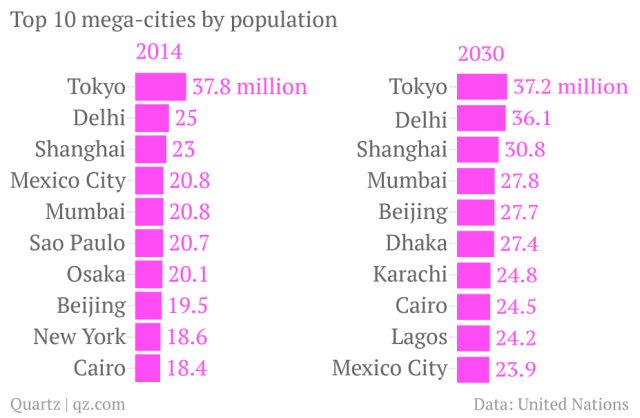This is how cities can fight climate change
Contents |
[edit] Introduction
Cities are a crucial area for taking action on climate change. By 2050, over two thirds of mankind will live in cities. Cities generate roughly 80% of global GDP and account for more than 60% of all CO2 emissions.
In Asia’s emerging economies, urbanisation is happening at a striking pace. In 2030, seven of the world’s 10 biggest urban centres will be in Asia. More than 55% of China’s population lives in cities today. By 2030, 70% or one billion Chinese will be living in urban areas.
[Image: Quartz]
Clearly, if we want any chance at all to mitigate climate change, we need to develop low-carbon cities. And that puts the spotlight on infrastructure. Infrastructure supports much of what attracts us to cities, including healthcare, education, innovation and culture. Intelligent infrastructure is key to reducing CO2 emissions.
[edit] What does a smart city actually mean?
'Smart cities' is the expression often used in this context. But what exactly is a smart city?
Advances in digitalisation and automation in infrastructure are making significant improvements possible, even through relatively small investments. For example, Siemens have shown how intelligent infrastructure can significantly outperform existing systems – for example, by speeding up traffic by 20%, increasing train capacity by 30%, cutting power consumption in buildings by 30%, or saving up to 40% in the build-out of power grids.
Here are some examples of the positive impact of intelligent technologies.
[Image: REUTERS/Jacky Naegelen]
Transportation is a crucial infrastructure for every city. Paris’ Metro Line 1 is the city’s oldest line and has been operating for 115 years. It transports around 750,000 people per day. Siemens upgraded it to a driverless metro system and increased the capacity by 20%.
[edit] The changing economics of renewables
2015's climate talks in Paris, COP21, conveyed the clear message that our energy mix needs to be diversified. Renewable energy sources such as solar, wind, and energy from waste not only reduce greenhouse gases but are becoming economically attractive.
For instance, the costs of electricity from solar panels has fallen 50% in the last five years. There was a similar drop in the price of rechargeable, lithium-ion batteries for the grid, and estimates indicate that the price will fall another 50% by 2020. This is having an impact on the power generation market. In 2014, nearly 60% of all new investments in power generation went to renewable energy sources.
Running existing power generation infrastructure more efficiently is another example. Reducing losses in transmission and distribution ultimately reduces pressure on the grid. It also lowers the amount of investment required to install new power generation capacities.
The last example relates to buildings. Globally, buildings consume about 40% of all primary energy and produce about one third of the total global energy-related CO2 emissions. Siemens optimised Dubai’s WAFI building complex which includes a hotel, a shopping mall and some health and leisure facilities with a state-of-the-art building automation system. This has cut energy consumption by close to 20%.
Urbanisation is one of the major challenges of this century. If we manage it wisely, we will chart the path to further growth and improve quality of life for more people on our planet. Urban planning and the use of intelligent infrastructure technologies are key levers in the fight against climate change.
Written by Roland Busch, Member of the Managing Board, Siemens AG
This article was also published on the Future of Construction Knowledge Sharing Platform and the WEF Agenda Blog.
--Future of Construction 09:08, 19 Jun 2017 (BST)
[edit] Find out more
[edit] Related articles on Designing Buildings Wiki
Featured articles and news
RTPI leader to become new CIOB Chief Executive Officer
Dr Victoria Hills MRTPI, FICE to take over after Caroline Gumble’s departure.
Social and affordable housing, a long term plan for delivery
The “Delivering a Decade of Renewal for Social and Affordable Housing” strategy sets out future path.
A change to adoptive architecture
Effects of global weather warming on architectural detailing, material choice and human interaction.
The proposed publicly owned and backed subsidiary of Homes England, to facilitate new homes.
How big is the problem and what can we do to mitigate the effects?
Overheating guidance and tools for building designers
A number of cool guides to help with the heat.
The UK's Modern Industrial Strategy: A 10 year plan
Previous consultation criticism, current key elements and general support with some persisting reservations.
Building Safety Regulator reforms
New roles, new staff and a new fast track service pave the way for a single construction regulator.
Architectural Technologist CPDs and Communications
CIAT CPD… and how you can do it!
Cooling centres and cool spaces
Managing extreme heat in cities by directing the public to places for heat stress relief and water sources.
Winter gardens: A brief history and warm variations
Extending the season with glass in different forms and terms.
Restoring Great Yarmouth's Winter Gardens
Transforming one of the least sustainable constructions imaginable.
Construction Skills Mission Board launch sector drive
Newly formed government and industry collaboration set strategy for recruiting an additional 100,000 construction workers a year.
New Architects Code comes into effect in September 2025
ARB Architects Code of Conduct and Practice available with ongoing consultation regarding guidance.
Welsh Skills Body (Medr) launches ambitious plan
The new skills body brings together funding and regulation of tertiary education and research for the devolved nation.
Paul Gandy FCIOB announced as next CIOB President
Former Tilbury Douglas CEO takes helm.
UK Infrastructure: A 10 Year Strategy. In brief with reactions
With the National Infrastructure and Service Transformation Authority (NISTA).


























